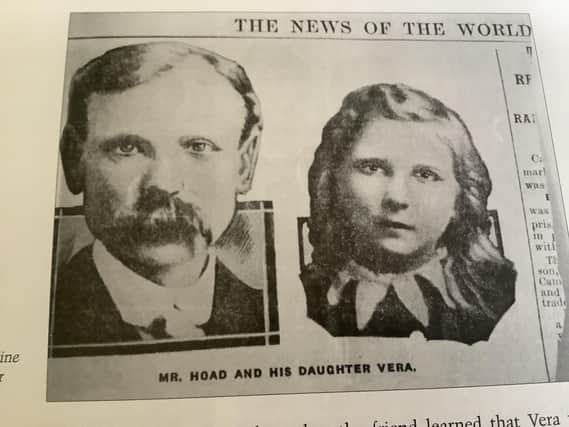100th anniversary of brutal Chichester murder of "bonny child of happy disposition"


Little Vera Hoad loved music, and on Monday, February 25, 1924, at 6.30pm she left her lesson and headed home to St Pancras. She was not seen alive again. Three days later she was found at Graylingwell, a layer of snow her only shroud. She had been strangled and violated.
The discovery rocked Chichester, and all manner of rumour did the rounds as police knocked on door after door in a vain effort to find a clue to the killer. A piece of cloth, perhaps from the killer’s clothes, sent shivers through the city. Washing hanging in the back garden became a rare sight.
Advertisement
Hide AdAdvertisement
Hide AdNo one dared offer anyone the chance to find a ripped garment. Two and two would have made five, six or seven in the climate of fear and suspicion. But time passed and the horror subsided.
Police inquiries continued, but little came to light. Scotland Yard was at its most diligent, but the person guilty of the atrocious crime was never traced. As The News Of The World wrote nine years later when Vera’s father took his own life, the tragedy passed into the pigeon holes of murders unsolved.
It was a crime inevitably which stayed a lifetime with little Vera’s childhood friend – and 30 years ago, the Chichester woman, on the 70th anniversary of Vera’s murder, broke a 70-year silence. Little Vera was her friend, a bright young girl she loved to play with. On a grim anniversary, she wanted everyone in Chichester to be thinking about her – and so she got in touch with me at the newspaper. The friend – completely understandably – didn’t want me to use her name, but she wanted Vera’s name to be in the paper.
Vera Hoad was a “bonny child of happy disposition and fair bobbed hair”, The Chichester Observer wrote when her strangled body was found at Graylingwell. Seventy years later, that’s just how her one-time friend still remembered her.
Advertisement
Hide AdAdvertisement
Hide Ad“She was a very bright little girl, always laughing, always joking, riding around on her bike,” she told me.
Aged 80, Vera’s friend spoke to me freely of the friend she lost to an unknown killer on February 25, 1924. Her memories were just as fresh now as they ever were. She and Vera used to meet before and after school, and the day 11-year-old Vera disappeared was no different.
“We were coming down the road and she was just going off for a music lesson. She said ‘cheerio, see you tomorrow’. I never saw her again. She was missing, I don’t know, three or four days, and all these rumours were going round.
"My mother wouldn’t let me know what was being said, but I flapped my ears. And then Vera was found at Graylingwell by a deaf and dumb patient. This dummy, as people used to call them, tried to get people to understand that he wanted someone to go with him, and it took him some time. When they got there, they found her. She was absolutely frozen solid on to the ground. They had to get a blow torch to release her.”
Advertisement
Hide AdAdvertisement
Hide AdOnly then, 70 years later, did her friend learn that Vera was strangled. The precise details of Vera’s dreadful fate were kept from her: “All I know was that we had the detectives coming round asking all these questions.
"They were going around with a piece of a shirt, a man’s shirt. People were frightened to hang their washing out after that if they had a patch on their shirts. There was a terrific to-do about the whole thing. Those days people had little to interest them so something like this was really big news. Nowadays people get murdered, and it is just one a week.
“The detectives were asking me if Vera played with boys, if I could say whether she had said anything. I couldn’t think whether or not she had. I was just too terrified. I hid behind my mother.
“I have been looking through a book on murders in Sussex, and I looked all through it and I couldn’t see any reference to this case, but it was a big noise at the time.
Advertisement
Hide AdAdvertisement
Hide Ad"She was buried in Westhampnett cemetery, now Portfield. It was just a simple grave with a headstone. I tried to find it the last time I was in the cemetery, and I couldn’t actually find it. I know the area. I’m sure I could find if I tried again some time.”
The woman didn’t attend the burial and didn’t even know it was on – again part of the protective cloak spread around her by her family. But afterwards she became good friends with Vera’s mother, a deeply religious woman who turned to séances in an attempt to solve the crime. A medium told her that it was someone called Jack who committed the murder, but Mrs Hoad knew no one of that name, and there it remained – a story that haunted Vera’s school friend for the rest of her life.
“I remember Vera so well. She was such a bright and happy sort of girl. I often used to wonder what she would have become if she had lived. I can see her now.”